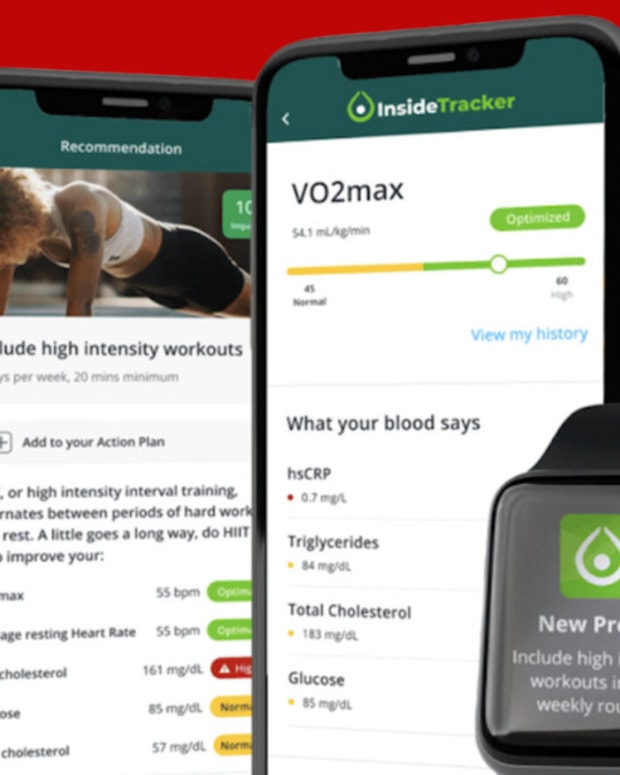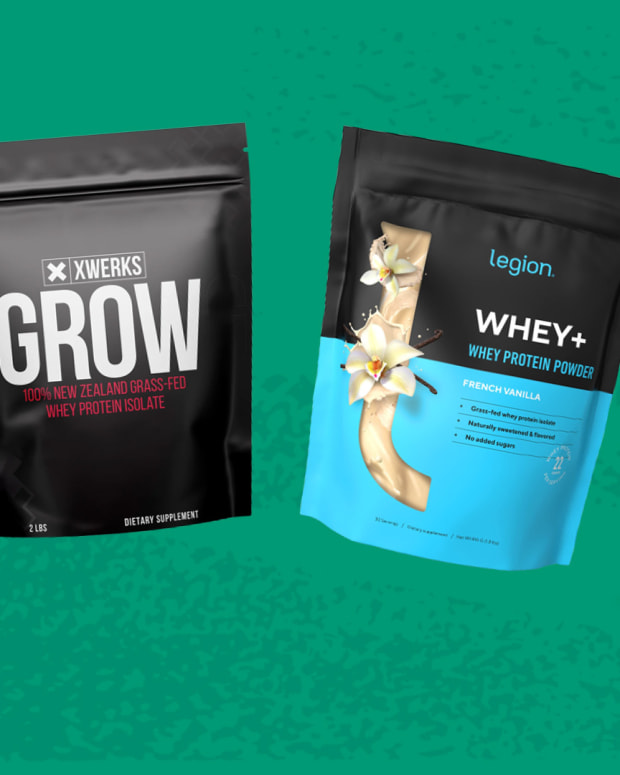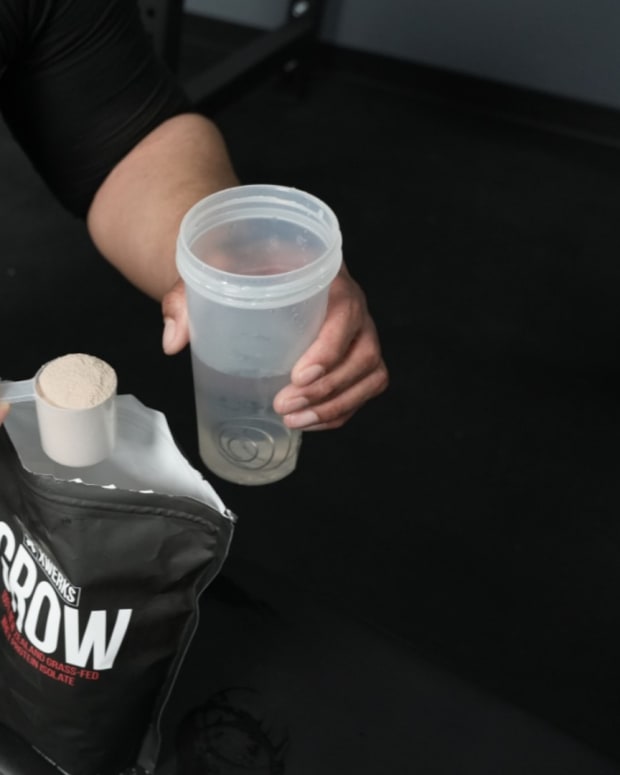The products featured in this article have been independently reviewed. When you buy something through the retail links on this page, we may earn commission at no cost to you, the reader. Sports Illustrated editorial staff are not involved in the creation of this content. Learn more here.
Whey protein powder is one of the most popular and commonly used nutritional supplements because it’s such a simple, convenient and effective way to increase your daily protein intake.
Everyone knows that protein is great for athletes and bodybuilders looking to build muscle, but protein has so many other important roles in the body that often go overlooked. For example, a high-protein diet that promotes muscle growth also increases your metabolism. Consuming a sufficient amount of protein is also essential for weight loss—a high-protein diet helps you feel full for a longer period of time and preserves lean muscle mass while in a caloric deficit(1), so you lose fat, not muscle.
We consulted with Sarah Falcone, BSN, RN and Pete Nastasi, a certified nutrition coach (CNC), to help us find the best whey protein powders on the market. Nastasi said, “Whey protein powder is a fantastic dietary tool because it’s easily digested and absorbed by most individuals, contains all of the essential amino acids our bodies need to preserve and build lean muscle tissue and is both accessible and affordable for most people.”
Throughout this article, Falcone and Nastasi provide valuable insight into the different types of whey protein powders available (concentrate, isolate and hydrolysate), which types will work best for you, what nutrition information to look for and which companies and brands are best in class.
About Our Scoring System
Products that we've tested for this article receive an overall score between 1 and 5, based on several categories weighted for importance. Scoring criteria for whey protein powders include the type of whey used (isolate, concentrate or hydrolysate), protein per serving and macronutrient calories per serving. Organic certifications, third-party testing and other quality indicators may increase a product's score. You can learn more in the methodology section following the product reviews.
If you follow a vegan or vegetarian lifestyle or are sensitive to lactose, check out our article on the best plant-based protein powders, which are great alternatives to whey protein.
Our Picks for the Best Whey Protein in 2024:
- Best Overall Whey Protein Powder: Transparent Labs 100% Grass-Fed Whey Protein Isolate
- Best Whey Protein for Weight Loss: XWerks Grow Whey Protein Isolate
- Best Grass-Fed Whey Protein: Legion Whey+
- Best Tasting Whey Protein: Gainful Protein Powder
- Best Whey Protein for Weight Gain: Transparent Labs Mass Gainer
- Best Whey Isolate Protein Powder: XWerks Grow Whey Protein Isolate
- Best Budget Whey Protein: Kaged Whey Protein Isolate
- Best Organic Whey Protein: Naked Nutrition Grass Fed Whey Protein Powder
- Best Whey Protein for Flavor Options: Legion Whey+
- Best Sugar-Free Whey Protein: Transparent Labs 100% Grass-Fed Whey Protein Isolate
- Best Unsweetened Whey Protein: Gainful Protein Powder
Best Overall Whey Protein Powder: Transparent Labs 100% Grass-Fed Whey Protein Isolate
Overall Score: 4.93/5
Key features and specs:
- Protein per serving: 28 grams
- Nutrition facts: 120 calories, 28 grams protein, 1 gram carbs, 0 grams fats
- Protein source: 100% grass-fed whey protein isolate
- Sweeteners: Natural flavoring and stevia
- Flavors: Milk Chocolate, French Vanilla, Chocolate Peanut Butter, Cinnamon French Toast, Mocha, Strawberry, Vanilla Peanut Butter, Oatmeal Chocolate Chip Cookie
- Subscription: Subscribe and save $6, plus free shipping
- Price per serving: $2.00 (one time), $1.80 (subscription)
Why I picked it:
No sugar, all protein—that’s what Transparent Labs set out to accomplish with its grass-fed whey protein isolate. This whey protein undergoes filtration(2), taking out the excess sugar, fat, carbs and lactose so you're giving your body the pure protein it needs to keep pushing. Whey isolate has the highest protein concentration of the different types of protein powders, and with Transparent Labs’ filtering process, this protein is a good option if you're trying to reduce your carb and fat intake.
Transparent Labs’ whey isolate protein powder packs 28 grams of protein into each serving—one of the highest on our list. We also like the flavor variety, including unique flavors like Cinnamon French Toast. Bonus: This protein isn’t too sweet, so you can mix it with fruit juice or add it to a fruit smoothie without feeling like you’re drinking a shake made with Fun Dip.
What we love:
- High protein per serving
- Reasonable price point
- No artificial ingredients
What to consider:
- Requires an electric blender for the best texture
- Facility also processes nuts, so the protein may not be nut-free
Best Whey Protein for Weight Loss: XWerks Grow Whey Protein Isolate
Overall Score: 4.58/5
Key features and specs:
- Protein per serving: 25 grams
- Nutrition facts: 110 calories, 25 grams protein, 1 gram carbs, 0 grams fats
- Protein source: 100% grass-fed whey protein isolate
- Sweeteners: Natural flavoring and stevia
- Flavors: Chocolate, Vanilla, Peanut Butter, Strawberry
- Subscription: Subscribe and save 5%
- Price per serving: $1.97 (one time), $1.87 (subscription)
Why I picked it:
XWerks Grow has a high protein content with almost no fat or carbs, making it our top choice for the best protein powder for weight loss.
All flavors (Chocolate, Vanilla, Peanut Butter and Strawberry) are naturally sweetened with stevia, which is intended to eliminate the bloating that is sometimes associated with artificially sweetened protein powders.
XWerks grow also contains all nine essential amino acids with 25 grams of protein per serving. It's free from hormones, antibiotics and pesticides.
Check out our XWerks Grow review for more information on this protein powder.
What we love:
- 100 percent grass-fed whey that’s free of hormones, antibiotics and pesticides
- No artificial sweeteners, flavors and colors
- Ultra-filtered to remove fat and most carbs
What to consider:
- Expensive
- Not suitable for those with dairy allergies
Best Grass-Fed Whey Protein: Legion Whey+
Overall Score: 4.60/5
Key features and specs:
- Protein per serving: 22 grams
- Nutrition facts: 110 calories, 23 grams of protein, 4 grams of carbs, 1 gram of fat
- Protein source: Whey protein isolate
- Sweeteners: Natural flavor, stevia leaf extract, monk fruit extract
- Flavors: Dutch Chocolate, French Vanilla, Birthday Cake, Chocolate Peanut Butter, Cocoa Cereal, Fruity Cereal, Honey Cereal, Cinnamon Cereal, Cookies & Cream, Mint Chocolate, Apple Pie, Banana Bread, Mocha Cappuccino, Pumpkin Pie, Salted Caramel, Strawberry Banana, Unflavored
- Subscription: Subscribe and save 10%
- Price per serving: $2.00 (one time), $1.80 (subscription)
Why I picked it:
Why is grass-fed whey protein better? Studies show that dairy sourced from grass-fed cows has a higher concentration of whey proteins and amino acids (3), Which may further support muscular training adaptations. The protein in Legion Athletics is Certified to contain no banned substances by Labdoor™, the gold standard of third-party lab testing (4). This helps ensure the protein isolate is in its purest, most nutritionally dense form without any interference from pesticides and growth hormones.
Additionally, Legion Athletics whey is filtered to remove extra carbs and fat, so you're only getting the good stuff with every serving. The removal of these elements is geared toward bloat-free digestion.
What we love:
- No artificial flavors, sweeteners or preservatives
- Lactose sugars are removed during the processing to yield whey protein isolate, so it should be easier on the stomach to digest than protein powders containing whey protein concentrate for those who are sensitive to lactose
- Labdoor tested for purity
What to consider:
- Contains a few filler ingredients, including xanthan gum (a thickening agent) and sunflower lecithin (to prevent clumping)
- Contains protein from animal sources, so those following a vegan diet should opt for Transparent Labs’ Vegan Protein instead
Best Tasting Whey Protein: Gainful Protein Powder
New customers get 30% off their first order
Overall Score: 4.2/5
Key features and specs:
- Protein per serving: 19–27 grams (varies based on your personalized formula)
- Nutrition facts: Depends on your specific formula, and ranges from 120-150 calories, 1.5 grams of fat, 0 grams of sugar and 1 gram of carbs
- Protein source: Depends on your formula, and may include whey protein isolate or concentrate, micellar casein, organic pea protein or organic brown rice protein
- Sweeteners: Monk fruit or stevia leaf extract
- Flavors: Strawberry Cream, Madagascar Vanilla, Rich Chocolate, Caffè Mocha, Cookies and Cream, Chocolate Peanut Butter, Matcha Green Tea, Cinnamon Toast, Sea Salt Caramel
- Subscription: Automatic, applies every month
- Price per serving: $3.21
Why I picked it:
As you’ve been researching protein powders, you’ve probably seen that one of the biggest general complaints is that it can taste “chalky” and leave an off-putting aftertaste if it isn’t made with quality ingredients. Our testing team gave Gainful a try (specifically the Caffe Mocha flavor), and liked the subtle, not-too-sweet flavor profile.
If you're not a fan of coffee flavors, Gainful offers nine total flavors in individual use packets, so you can pick and choose what you’re craving each day. Nastasi says the Chocolate Peanut Butter, Caffe Mocha and Sea Salt Caramel are his favorites.
Close runners up for best tasting protein powder include XWerks Chocolate flavor (our team says this tastes like hot chocolate made with real cocoa powder), Transparent Labs Chocolate Peanut Butter flavor (Nastasi says this tastes like a chocolate-PB milkshake) and GHOST protein powders, especially the Chips Ahoy flavor.
What we love:
- Protein powder formula is made specifically for you
- Nine flavor options
- Vegan, keto and whey protein options
- Gluten- and soy-free
What to consider:
- Only four flavor packets come with a single order
- Not for shoppers on a budget
Best Whey Protein for Weight Gain: Transparent Labs Mass Gainer
Overall score: 4.2/5
Key features and specs:
- Protein per serving: 53 grams
- Nutrition facts: 790 calories, 114 grams carbs, 14 grams fat (Chocolate Glaze Donut); 760 calories, 109 grams carbs, 13 grams fat (Sweet Vanilla)
- Protein source: Grass-fed whey protein isolate
- Sweetener: Stevia
- Flavors: Sweet Vanilla, Chocolate Glaze Donut
- Subscription: Subscribe & save $8, plus free shipping
- Price per serving: $5.13
Why I picked it:
For those looking to gain more muscle and overall body mass, adding more protein to your diet may be a game-changer. Transparent Labs Mass Gainer, our top pick for best whey protein for weight gain, uses grass-fed whey concentrate to maximize your protein consumption; in fact, you’ll get around 53 grams of protein in every serving.
To boost your protein intake, you can opt to mix this mass gainer with milk instead of water. This protein powder can be taken one to three times a day depending on your needs, and can be blended with fruits and nut butters to make it a meal replacement shake.
Related Post: The Best Protein Powders for Muscle Gain
What we love:
- 53 grams of protein per serving
- Uses whey protein concentrate for maximum protein and calorie intake
- Third-party tested
What to consider:
- Not for users trying to lose weight
- Elevated price per serving
Best Whey Isolate Protein Powder: XWerks Grow Whey Protein Isolate
Overall Score: 4.58/5
Key features and specs:
- Protein per serving: 25 grams
- Nutrition facts: 110 calories, 25 grams protein, 1 gram carbs, 0 grams fats
- Protein source: 100% grass-fed whey protein isolate
- Sweeteners: Natural flavoring and stevia
- Flavors: Chocolate, Vanilla, Peanut Butter, Strawberry
- Subscription: Subscribe and save 5%
- Price per serving: $1.97 (one time), $1.87 (subscription)
Why I picked it:
XWerks Grow offers a whey protein isolate formula that’s ultra-filtered to remove excess carbohydrates and fats. Thus, this protein may be more efficiently digested and also easier on the digestive system as it is free of common allergens like lactose (6).
The whey in XWerks Grow is sourced from 100 percent grass-fed New Zealand cows, meaning it doesn’t contain pesticides, hormones or antibiotics. The protein is flavored with cocoa bean, vanilla bean and peanut butter powder. Plus, it’s free of all artificial sweeteners, flavors and coloring, and this protein powder is keto-friendly, gluten-free and soy-free.
With only 110 calories, one gram of carbs and zero grams of fat or sugar, it’s a great option for those trying to keep their post-workout shake low calorie and low macro. Overall, for those willing to spend more for “clean” products, this is a solid protein supplement.
What we love:
- 100 percent grass-fed whey that’s free of hormones, antibiotics and pesticides
- No artificial sweeteners, flavors and colors
- Ultra filtered to remove fat and most carbs
What to consider:
- Expensive
- Not suitable for those with dairy allergies
Best Budget Whey Protein: Kaged Whey Protein Isolate
Overall score: 4.3/5
Key features and specs:
- Protein per serving: 25 grams
- Nutrition facts: 110 calories, 2 grams carbs, 0 grams fat
- Protein source: Whey protein isolate
- Flavors: S’mores, Chocolate Peanut Butter, Chocolate, Vanilla
- Sweetener: Stevia
- Subscription: Subscribe & save 10%
- Price per serving: $1.16
Why I picked it:
Protein powder can be pricey, but Kaged may be able to help you stretch your dollar when it comes to getting a quality protein at a fair price. Each tub contains about 44 servings, which equates to $1.16 per serving. A single scoop yields 25 grams of protein, 12 grams of amino acids and six grams of BCAAs, including leucine, a stimulant for muscle protein synthesis (7).
Kaged formulates this protein for easy digestion and without any gluten, artificial flavors or GMO components. You’ll also have five flavors to choose from, including unique flavors like S’mores and Cinnamon French Toast.
What we love:
- Good value for the price
- Made with quality ingredients
- Packs in 25 grams of protein per serving
What to consider:
- Not for those with lactose sensitivities
Best Organic Whey Protein: Naked Nutrition Grass Fed Whey Protein Powder
Overall Score: 4.60/5
Key features and specs:
- Protein per serving: 25 grams
- Nutrition facts: 120 calories, 25 grams of protein, 3 grams of carbs, 2 grams of fats
- Protein source: Whey protein concentrate
- Sweeteners: Organic coconut sugar
- Flavors: Chocolate, Vanilla, Strawberry, Unflavored
- Subscription: Subscribe and save 20%
- Price per serving: $1.25
Why I picked it:
If you follow an all-natural diet, Naked Nutrition’s organic whey protein should be on your radar. This whey is a no-frills protein powder with one simple ingredient in the unflavored version: whey protein concentrate. The flavored versions add only organic coconut sugar and organic cacao powder (Chocolate flavor), natural vanilla flavor (Vanilla flavor) or dried strawberries (Strawberry flavor). It’s sourced from small California dairy farms where the cows are raised without growth hormones like rBGH or rBST and are grass-fed year-round.
Naked whey packs 25 grams of protein in each serving with 5.9 grams of BCAAs to help promote muscle protein synthesis and recovery with training (8). Plus, Naked Whey offers a 20% discount with a subscription.
For more in-depth information on this protein powder, check out our Naked Nutrition Whey Protein Powder review.
What we love:
- Excellent customer ratings—5/5 stars from 1,515 reviews at the time of writing
- High purity formula
- Cold processed to ensure amino acids, omega-3s and antibodies from the milk protein are not altered
What to consider:
- Whey concentrate may not be the best for those with lactose sensitivity
Best Whey Protein for Flavor Options: Legion Athletics Whey+
Overall Score: 4.6/5
Key features and specs:
- Protein per serving: 22 grams
- Nutrition facts: 110 calories, 23 grams of protein, 4 grams of carbs, 1 gram of fat
- Protein source: Whey protein isolate
- Sweeteners: Natural flavor, stevia leaf extract, monk fruit extract
- Flavors: Dutch Chocolate, French Vanilla, Birthday Cake, Chocolate Peanut Butter, Cocoa Cereal, Fruity Cereal, Honey Cereal, Cinnamon Cereal, Cookies & Cream, Mint Chocolate, Apple Pie, Banana Bread, Mocha Cappuccino, Pumpkin Pie, Salted Caramel, Strawberry Banana, Unflavored
- Subscription: Subscribe and save 10%
- Price per serving: $2.00 (one time), $1.80 (subscription)
Why I picked it:
Why stick to one flavor of protein powder when you can have sixteen? Legion Athletics takes a different formulation approach than other traditional protein powders with their non-traditional flavors, making it easy to enjoy a tasty protein shake. If you’re looking for a strawberry banana morning shake or salted caramel post-workout treat, Legion gives you that option. Plus, all flavors are made with pure Truly Grass Fed™ milk from hormone- and antibiotic-free cows.
What we love:
- No artificial flavors, sweeteners or preservatives
- Lactose sugars are removed during the processing to yield whey protein isolate
- Labdoor tested for purity
What to consider:
- Contains a few filler ingredients, including xanthan gum (a thickening agent) and sunflower lecithin (to prevent clumping)
Best Sugar-Free Whey Protein: Transparent Labs Whey Protein Isolate
Overall Score: 4.93/5
Key features and specs:
- Protein per serving: 28 grams
- Nutrition facts: 120 calories, 28 grams protein, 1 gram carbs, 0 grams fats
- Protein source: 100% grass-fed whey protein isolate
- Sweeteners: Natural flavoring and stevia
- Flavors: Milk Chocolate, French Vanilla, Chocolate Peanut Butter, Cinnamon French Toast, Mocha, Strawberry, Vanilla Peanut Butter, Oatmeal Chocolate Chip Cookie
- Subscription: Subscribe and save $6, plus free shipping
- Price per serving: $2.00 (one time), $1.80 (subscription)
Why I picked it:
If you’ve been working hard to make progress on your health and fitness goals, you likely don't want to worry about taking in artificial junk with your protein. Transparent Labs produces its grass-fed whey protein isolate with no artificial preservatives, colors and sweeteners. Instead, you’ll find only stevia and 28 grams of protein.
Transparent Labs prides itself on providing customers with the highest quality, most impactful products for their health. With third-party testing and certificates showing product analysis and composition, this whey protein aims to provide you with the nutrients your body needs as you work towards your goals. (We also included this top tier supplement in our list of the best protein powders for women.)
What we love:
- Grass-fed whey protein isolate is high protein, low fat and low carb
- No sugars
- Gluten-free formula
What to consider:
- Not the best option for those with dairy allergies
Best Unsweetened Whey Protein: Gainful Protein Powder
New customers get 30% off their first order
Overall Score: 4.2/5
Key features and specs:
- Protein per serving: 19–27 grams (varies based on your personalized formula)
- Nutrition facts: Depends on your specific formula, and ranges from 120-150 calories, 1.5 grams of fat, 0 grams of sugar and 1 gram of carbs
- Protein source: Depends on your formula, and may include whey protein isolate, whey protein concentrate, micellar casein, organic pea protein or organic brown rice protein
- Sweeteners: Monk fruit or stevia leaf extract
- Flavors: Strawberry Cream, Madagascar Vanilla, Rich Chocolate, Caffè Mocha, Cookies and Cream, Chocolate Peanut Butter, Matcha Green Tea, Cinnamon Toast, Sea Salt Caramel
- Subscription: Automatic, applies every month
- Price per serving: $3.21
Why I picked it:
Drinking one flavor of protein powder can be tiresome. Sometimes, having a flavorless, unsweetened option is the better choice, since it can easily be added to your smoothie, coffee or even baked goods. Gainful offers just that with its personalized protein powder that arrives flavor-free and unsweetened. You can add optional stevia-sweetened flavor packets or leave them out.
Each batch of protein powder is unique and tailored to meet your specific needs, matching your goals with a specific protein source, including whey, casein or plant-based options. The end result is personalized protein powder containing seven ingredients or less, sans any gluten, soy or fillers. Behind the scenes, each component added to Gainful's protein powder is carefully thought out and chosen by registered dietitian nutritionists to support your goals, whether that’s weight loss or muscle gain.
What we love:
- Tailor-made to your needs
- No artificial dyes, sweeteners, fillers or flavors
- Several protein options besides whey, such as keto and vegan
- Gluten- and soy-free
What to consider:
- A higher cost per serving than other brands
- Each bag comes with only 14 servings
What Is Whey Protein?
Whey protein is a concentrated protein source derived from cow’s milk, which contains two major proteins called casein and whey (9). Whey accounts for 20 percent of milk protein, and is considered a high-quality protein source. Cow’s milk protein is considered a complete protein because it contains all nine essential amino acids in proportions required by the body (10).
Beyond basic nutrition, whey protein (11) may offer specific health benefits, such as enhanced immune function (12) and cardiometabolic health (13). Usually, whey is sold in powder form, which can be blended with water or other liquids or added to soft foods. Also, people use whey protein powder in cooking, which adds nutritional value to baked goods. Food manufacturers use whey formulations rather than cream, butter or egg ingredients to make high-protein, low-fat products.
Related Post: Pea Protein vs Whey Protein: Which Is Better?
What Are the Three Types of Whey Protein?
When you browse online or at your local nutrition shop for whey protein products, you’ll probably notice different forms of whey. The main difference in the types of whey protein is how they’re processed. When you understand how they’re made, you can better choose the right type for your health and fitness goals. Here are the three most common forms of whey protein.
Concentrate
Whey protein concentrate (WPC) is the least processed form of whey, so it contains the highest levels of lactose (milk sugar), fat, carbohydrates and nutrients. Food manufacturers use WPC (14) to replace fresh dairy and eggs in products like sauces, soups and baked goods because it adds flavor, color and texture and extends shelf-life (15). However, it has the lowest protein content out of the three—typically 70 to 80 percent.
Isolate
Whey protein isolate (WPI) is made when whey is filtered and processed. It contains the most protein, 90 percent or more, and less lactose. For this reason, sports nutrition companies often prefer WPI for use in supplements, protein bars and other protein products because of the higher protein content (16). However, it lacks some of the beneficial nutrients found in the concentrated form (17).
Hydrolysate
Whey protein hydrolysate (WPH), also known as hydrolyzed whey, is produced by a process called partial hydrolysis, which breaks down whey protein for easier absorption (18). WPH is digested faster than WPC or WPI (19), so it causes a 28 to 43 percent increase in blood sugar levels (20). Diabetics don’t have to worry about this, though. Protein digestion is slow. In fact, recent research suggests that whey protein improves glycemic (blood sugar) control (21).
Benefits of Whey Protein Powder
The real benefit of a whey protein powder is that it’s an incredibly convenient and high-quality source of dietary protein. That being said, if you consume enough dietary protein through meat, dairy, legumes and other foods, then you don’t need a protein powder to achieve your health and fitness goals. However, if you're having trouble consuming enough protein through your diet alone, then adding a protein powder to your daily routine can have some real benefits.
Building muscle
Whey protein is rich in the essential amino acids, including the BCAAs, which can be beneficial for support muscle integrity and growth with training (22). Adding a whey protein shake to your daily diet can be a great way to help maximize your dietary protein intake and stimulate muscle growth.
Preserving lean muscle mass
When you’re in a caloric deficit with the goal of losing weight, you want to ensure that the weight you’re losing is primarily fat and not muscle. Eating a diet rich in protein helps preserve the lean muscle mass you’ve worked hard to achieve and enables your body to prioritize burning fat for energy.
Weight loss
Consuming whey protein has a satiating effect, meaning that it helps you feel full for a longer period of time. High protein diets help with weight loss by regulating your hunger levels and therefore reducing the amount of total calories you consume throughout the day.
How to Use Whey Protein Powder
In order to properly use a whey protein powder, you should first determine how much protein you should be eating on a daily basis. The amount of protein you consume is dependent on your fitness goals and current body weight, activity level and physique. A simple way to calculate your daily protein intake is by multiplying your body weight by 0.8. The resulting number is how many grams of protein you should consume each day. This should provide most active individuals with sufficient protein intake. Remember that whey protein powder is a supplement, and shouldn’t be your main source of dietary protein.
As far as how to actually consume this protein powder, you should follow the instructions on the supplement label, which usually entails mixing one scoop of protein powder with 10 to 12 ounces of your favorite beverage. It can also be mixed in a smoothie or foods like oatmeal and pancake batter. Whey protein powder can be consumed at any time of the day, but it’s usually utilized as a post-workout supplement to begin repairing muscle tissue.
Potential Side Effects of Whey Protein Powder
When used in moderation, protein powder is free of side effects and generally considered safe for healthy adults. That being said, consuming large amounts of protein powder can lead to digestive issues, dehydration and (potentially) nutrient deficiencies. It’s important to use a whey protein powder as part of a balanced diet and not as your main source of dietary protein. If you experience any unusual symptoms after using protein powder, stop use immediately and consult a healthcare professional.
Related Post: The Best Alternatives to Whey Protein
Who Should Use Whey Protein?
A whey protein powder will benefit anyone who is looking to increase their daily protein consumption and has trouble doing so through their diet alone. This is especially relevant for very active individuals, such as athletes, bodybuilders and fitness enthusiasts who have increased protein demands due to their workouts and training.
Another segment of the population that may benefit from using a whey protein powder is older adults. As we age, our bodies become less efficient at absorbing protein from food(23), and using protein supplements can be an easy way for the elderly to meet their daily protein needs and support muscle health.
How to Choose the Best Whey Protein for You
When picking a whey protein product, there are a few factors to consider, including the type of protein, taste, nutrition, additives/allergies and price.
Type of protein (whey concentrate, isolate or hydrolysate)
Check the ingredients list to see what type of whey the protein powder contains. Some brands will use a blend of whey forms.
- Whey concentrates have the most nutrients, but slightly less protein. They also contain more lactose, which may trigger lactose sensitivities.
- Whey isolates have more protein, but less fat and carbs, so they’ll likely be lower in calories. They may also be more expensive, since they require more processing.
- Whey hydrolysates may be easier to digest and absorbed faster
(24), so if you’re looking for a post-workout recovery shake, a hydrolysate might be the best choice to deliver muscle-building proteins.
Related Post: Whey Concentrate vs Whey Isolate: What's The Difference?
Taste
Whey proteins come in a wide variety of flavors. You’ll find options from unflavored to vanilla, chocolate orange and summer berries, to name a few. Taste is important because you want a protein supplement you’ll enjoy. When just starting to supplement your protein intake, try a small container or buy samples of flavors you might enjoy and get creative with your add-ins. You can try fruits, flavored milks or juices to create new flavors that fit your taste preference.
Nutrition
Check the whey protein label for the amount of protein per serving, and factor it into your daily protein intake. Most protein powders have around 25 grams per serving, which is an ideal dosage to maximize muscle protein synthesis(25). Also look for calories, fats, carbs, fiber, vitamins and minerals and even amino acid profiles. Make sure that the supplement you choose gives you the maximum benefit without unnecessary add-ins.
Additives/allergies
Read the ingredients section, too. Look for additives or allergens that you want or need to avoid. For example, labels warn you if the whey powder contains soy or was processed in a facility with nuts.
Price
The protein powders on our list give you a good idea of the price range for whey supplements. Our top picks vary from $1.16 to $3.41 per serving or $33.99 to $94.99 per container, so there’s an option for most budgets.
Our Methodology: How We Chose the Best Whey Protein Powders
We chose products for our list of the best whey protein powders based on a number of factors reflected in our whey protein powder scoring methodology. These include:
- Protein source: Whey protein is available as a concentrate, isolate, hydrolysate or blend. We rank whey isolates and hydrolysates higher than concentrates because they are easier to digest and filtered to remove carbs and fat.
- Macronutrient calories per serving: We prioritize whey protein powders with the most calories from protein—as opposed to fat or carbs.
- Total protein per serving: While everyone has varying protein needs, 25-30 grams of protein is generally recommended with each snack or meal. This amount is also the best value per serving of protein powder.
- Price per gram of protein: While price isn't always indicative of quality or value, we do reward whey protein powders that are more affordable, though we give this category less weight than the others.
- Sweeteners: We consider research about common sweeteners when assessing which whey protein powder formulas provide the least health risks to users.
- Bonus credits: Whey protein powders can earn small bumps in their overall score by having third-party testing credentials, no proprietary blends, an organic certification, sustainable packaging and the addition of digestive enzymes.
We also receive input from our panel of expert contributors, which includes registered dietitians and highly credentialed experts in sports nutrition and exercise science.
Learn more about our nutrition and supplement review process, as well as our whey protein powder scoring methodology.
Whey Protein Powder FAQs
How often should I consume whey protein?
It depends on your body’s unique needs and health and fitness goals. You should include protein with meals or snacks every three to five hours (26), but no one should rely solely on protein powder because that would eliminate other nutritious whole foods from the diet.
One whey protein drink per day is reasonable. Check with your doctor if you want to use whey protein to replace more than one meal.
Is whey protein powder safe?
Yes, whey protein powder is generally considered safe for healthy individuals when used in moderation. If you have any pre-existing medical conditions or have a severe lactose intolerance, then it’s recommended to consult with a healthcare professional before adding a whey protein powder to your diet.
What is the best time to take whey protein powder?
There really is no “best time” to take a whey protein powder supplement. Instead, when to consume whey protein is dependent on your individual goals and lifestyle. Some people enjoy a protein shake in the morning as a quick and easy breakfast option they can have on-the-go, while others prefer to consume it immediately after a workout to support muscle growth and recovery.
Just remember that whey protein powder should be used as a supplement to a well balanced diet, and should not be used as a replacement for whole nutrient-dense foods. The timing of when you consume the whey protein is less important than your overall protein intake throughout the day.
Does whey protein cause hair loss?
Dr. Larry Shapiro suggests that “WPI contains highly concentrated amounts of amino acids that cause the body to increase testosterone, which breaks down into dehydroxytestosterone (DHT), a hormone proven to cause hair loss.” However, no published medical studies show this to be the case.
Can whey protein powder help with weight loss?
From keeping you satiated to helping you improve your performance in the gym, whey protein powder can certainly help you lose weight. Research has even shown that whey protein may reduce abdominal fat when combined with weight training (27).
What are the disadvantages of whey protein?
If overused, whey protein can cause side effects (28), including kidney or liver damage, aggression, acne and a disruption in gut bacteria. Since most people don't consume more than one serving of whey protein per day, overconsumption is rare and takes time to develop. If you would like to add an extra layer of protection for your gut bacteria, you can even take a high-quality prebiotic or ensure you consume a variety of fruits and vegetables on a regular basis.
How do I know if my whey is good quality?
The best way to know if your whey protein is high quality is to read the labels. Check out the whey source, nutritional profile and ingredient list. Quality wheys use traceable, organic and certified ingredients. Also, high-quality whey products avoid fillers and artificial sweeteners. Another sign that you have a good quality whey is when the labels include certifications and seals from third-party approvals. These show that the manufacturer has proven the quality by established standards.
Expert Contributors
Chris Mohr, RD and Ph.D.
Chris Mohr is a registered dietitian who holds a Ph.D. in exercise physiology. He has worked with athletes ranging from NFL players to WWE wrestlers, along with celebrities and executives worldwide. He has been a featured speaker at many conferences around the world.
Mike Roberts, Ph.D.
Roberts is a Professor in the School of Kinesiology at Auburn University where he serves as the Director for the Nutrabolt Applied and Molecular Physiology Lab. He currently has over 190 publications in several preeminent physiology and nutrition journals, serves in senior editor roles for various physiology journals and has given numerous lectures at regional, national and international scientific conferences and venues.
Eddie Jo, Ph.D.
Eddie Jo is a professor of exercise physiology and the director of the Cal Poly Pomona Human Performance Research Lab. His research serves to innovate and advance the application of exercise training methodologies, nutrient intake and technologies for the optimization of human health and performance, energy metabolism, body composition and endocrine function.
Tim Ziegenfuss, PhD, CSCS, FISSN
Tim Ziegenfuss, PhD, CSCS, FISSN, is a standout in the world of sports nutrition and exercise science, bolstered by graduate degrees from Purdue University and Kent State University. Beyond academia, he serves as a Past President and Fellow of The International Society of Sports Nutrition. As CEO of The Center for Applied Health Sciences, his focus is overseeing innovative research with real-world impact and guiding product ideation and creation for major retailers all around the world.
Jenevieve Roper, Ph.D, CSCS.
Dr. Jen Roper is an Associate Professor of Health and Human Sciences at Loyola Marymount University. She received her PhD in Physical Education, Sports and Exercise Science in 2015 from the University of New Mexico, with a specialization in Exercise Science and Biomechanics. She currently teaches a wide variety of courses, including Nutrition, Kinesiology and Scientific Principles of Strength & Conditioning.
Additional contributors:
- Pete Nastasi, Certified Nutrition Coach
- Sarah Falcone, Registered Nurse
References
- Pesta, D. H., & Samuel, V. T. (2014). A high-protein diet for reducing body fat: mechanisms and possible caveats. Nutrition & metabolism, 11(1), 53. https://doi.org/10.1186/1743-7075-11-53
- Seema Patel, Functional food relevance of whey protein: A review of recent findings and scopes ahead, Journal of Functional Foods, Volume 19, Part A, 2015. https://doi.org/10.1016/j.jff.2015.09.040
- Alothman, M., Hogan, S. A., Hennessy, D., Dillon, P., Kilcawley, K. N., O'Donovan, M., Tobin, J., Fenelon, M. A., & O'Callaghan, T. F. (2019). The "Grass-Fed" Milk Story: Understanding the Impact of Pasture Feeding on the Composition and Quality of Bovine Milk. Foods (Basel, Switzerland), 8(8), 350. https://doi.org/10.3390/foods8080350
- Labdoor. (2023). https://labdoor.com/
- Pasiakos, S. M., McLellan, T. M., & Lieberman, H. R. (2015). The effects of protein supplements on muscle mass, strength, and aerobic and anaerobic power in healthy adults: a systematic review. Sports medicine (Auckland, N.Z.), 45(1), 111–131. https://doi.org/10.1007/s40279-014-0242-2
- Hoffman, J. R., & Falvo, M. J. (2004). Protein - Which is Best?. Journal of sports science & medicine, 3(3), 118–130. https://www.ncbi.nlm.nih.gov/pmc/articles/PMC3905294/#ref29
- Gwin, J. A., Church, D. D., Wolfe, R. R., Ferrando, A. A., & Pasiakos, S. M. (2020). Muscle Protein Synthesis and Whole-Body Protein Turnover Responses to Ingesting Essential Amino Acids, Intact Protein, and Protein-Containing Mixed Meals with Considerations for Energy Deficit. Nutrients, 12(8), 2457. https://doi.org/10.3390/nu12082457
- Khemtong, C., Kuo, C. H., Chen, C. Y., Jaime, S. J., & Condello, G. (2021). Does Branched-Chain Amino Acids (BCAAs) Supplementation Attenuate Muscle Damage Markers and Soreness after Resistance Exercise in Trained Males? A Meta-Analysis of Randomized Controlled Trials. Nutrients, 13(6), 1880. https://doi.org/10.3390/nu13061880
- Davoodi, S. H., Shahbazi, R., Esmaeili, S., Sohrabvandi, S., Mortazavian, A., Jazayeri, S., & Taslimi, A. (2016). Health-Related Aspects of Milk Proteins. Iranian journal of pharmaceutical research : IJPR, 15(3), 573–591. https://www.ncbi.nlm.nih.gov/pmc/articles/PMC5149046/
- Miller, D. G., Jarvis, K. J., & McBean, D. L. Dairy Foods and Nutrition. https://books.google.com.br/books?
- Shah N. P. (2000). Effects of milk-derived bioactives: an overview. The British journal of nutrition, 84 Suppl 1, S3–S10. https://doi.org/10.1017/s000711450000218x
- Ewan Ha, Michael B. Zemel, Functional properties of whey, whey components, and essential amino acids: mechanisms underlying health benefits for active people (review), The Journal of Nutritional Biochemistry,Volume 14, Issue 5, 2003, https://doi.org/10.1016/S0955-2863(03)00030-5.
- Fekete, Á. A., Givens, D. I., & Lovegrove, J. A. (2016). Can milk proteins be a useful tool in the management of cardiometabolic health? An updated review of human intervention trials. The Proceedings of the Nutrition Society, 75(3), 328–341. https://doi.org/10.1017/S0029665116000264
- USDA's National Organic Program. Whey Protein Concentrate. https://www.ams.usda.gov/sites/default/files/media
- United States Dairy Export Council. 2004. Reference Manual for U.S. Whey and Lactose Products. U.S. Dairy Export Council; Arlington, VA. Retrieved on May 31, 2016 from: http://usdec.files.cms-plus.com/PDFs/2008ReferenceManuals/Whey_Lactose
- Hoffman, J. R., & Falvo, M. J. (2004). Protein - Which is Best?. Journal of sports science & medicine, 3(3), 118–130. https://www.ncbi.nlm.nih.gov/pmc/articles/PMC3905294/
- Patel S. (2015). Emerging trends in nutraceutical applications of whey protein and its derivatives. Journal of food science and technology, 52(11), 6847–6858. https://doi.org/10.1007/s13197-015-1894-0
- Morifuji, M., Ishizaka, M., Baba, S., Fukuda, K., Matsumoto, H., Koga, J., Kanegae, M., & Higuchi, M. (2010). Comparison of different sources and degrees of hydrolysis of dietary protein: effect on plasma amino acids, dipeptides, and insulin responses in human subjects. Journal of agricultural and food chemistry, 58(15), 8788–8797. https://doi.org/10.1021/jf101912n
- Nakayama, K., Tagawa, R., Saito, Y., & Sanbongi, C. (2019). Effects of whey protein hydrolysate ingestion on post-exercise muscle protein synthesis compared with intact whey protein in rats. Nutrition & metabolism, 16, 90. https://doi.org/10.1186/s12986-019-0417-9
- Power, O., Hallihan, A., & Jakeman, P. (2009). Human insulinotropic response to oral ingestion of native and hydrolysed whey protein. Amino acids, 37(2), 333–339. https://doi.org/10.1007/s00726-008-0156-0
- Chiang, S. W., Liu, H. W., Loh, E. W., Tam, K. W., Wang, J. Y., Huang, W. L., & Kuan, Y. C. (2022). Whey protein supplementation improves postprandial glycemia in persons with type 2 diabetes mellitus: A systematic review and meta-analysis of randomized controlled trials. Nutrition research (New York, N.Y.), 104, 44–54. https://doi.org/10.1016/j.nutres.2022.04.002
- Stokes, T., Hector, A. J., Morton, R. W., McGlory, C., & Phillips, S. M. (2018). Recent Perspectives Regarding the Role of Dietary Protein for the Promotion of Muscle Hypertrophy with Resistance Exercise Training. Nutrients, 10(2), 180. https://doi.org/10.3390/nu10020180
- Baum, J. I., Kim, I. Y., & Wolfe, R. R. (2016). Protein Consumption and the Elderly: What Is the Optimal Level of Intake?. Nutrients, 8(6), 359. https://doi.org/10.3390/nu8060359
- Mignone, L. E., Wu, T., Horowitz, M., & Rayner, C. K. (2015). Whey protein: The "whey" forward for treatment of type 2 diabetes?. World journal of diabetes, 6(14), 1274–1284. https://doi.org/10.4239/wjd.v6.i14.1274
- Phillips, S. M., & Van Loon, L. J. (2011). Dietary protein for athletes: from requirements to optimum adaptation. Journal of sports sciences, 29 Suppl 1, S29–S38. https://doi.org/10.1080/02640414.2011.619204
- Kårlund, A., Gómez-Gallego, C., Turpeinen, A. M., Palo-Oja, O. M., El-Nezami, H., & Kolehmainen, M. (2019). Protein Supplements and Their Relation with Nutrition, Microbiota Composition and Health: Is More Protein Always Better for Sportspeople?. Nutrients, 11(4), 829. https://doi.org/10.3390/nu11040829
- Hulmi, J. J., Laakso, M., Mero, A. A., Häkkinen, K., Ahtiainen, J. P., & Peltonen, H. (2015). The effects of whey protein with or without carbohydrates on resistance training adaptations. Journal of the International Society of Sports Nutrition, 12, 48. https://doi.org/10.1186/s12970-015-0109-4
- Vasconcelos, Q. D. J. S., Bachur, T. P. R., & Aragão, G. F. (2021). Whey protein supplementation and its potentially adverse effects on health: a systematic review. Applied physiology, nutrition, and metabolism = Physiologie appliquee, nutrition et metabolisme, 46(1), 27–33. https://doi.org/10.1139/apnm-2020-0370
These statements have not been evaluated by the Food and Drug Administration. These products are not intended to diagnose, treat, cure, or prevent any diseases.
Prices are accurate and items in stock as of publish time.



















